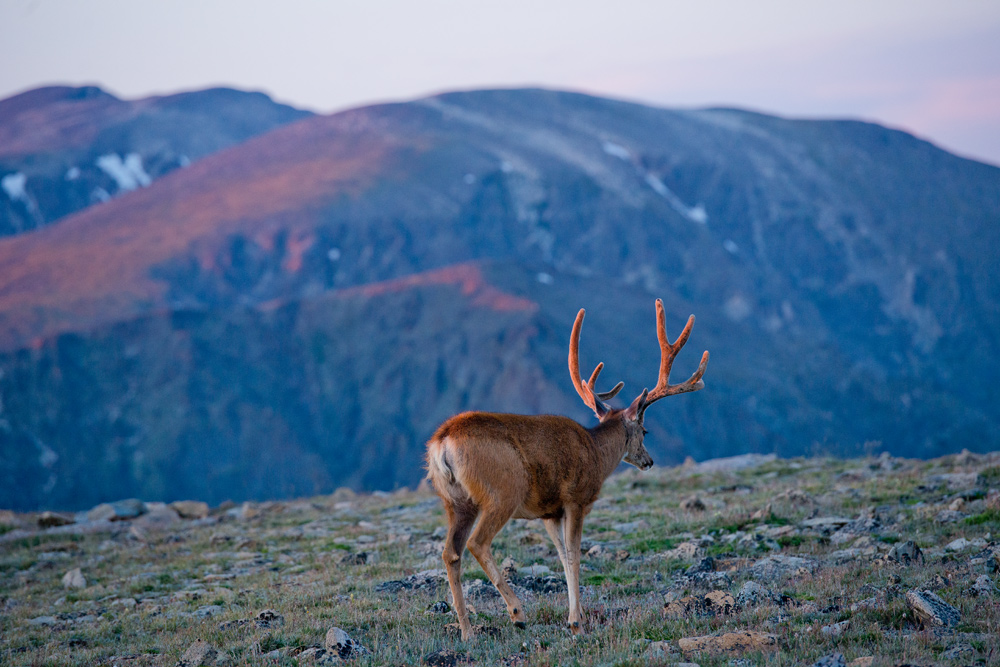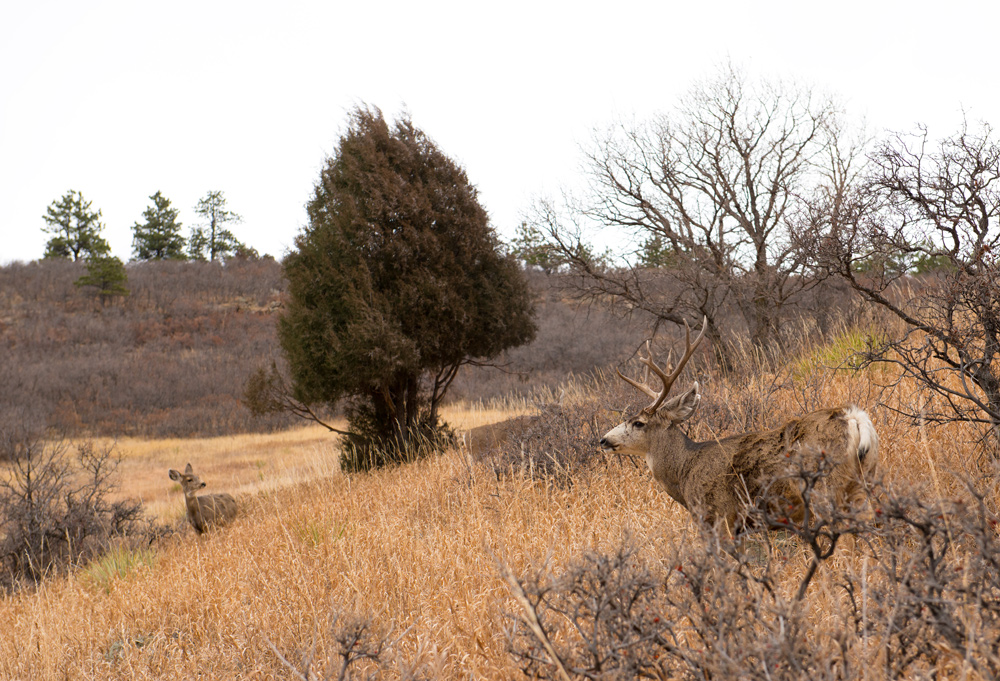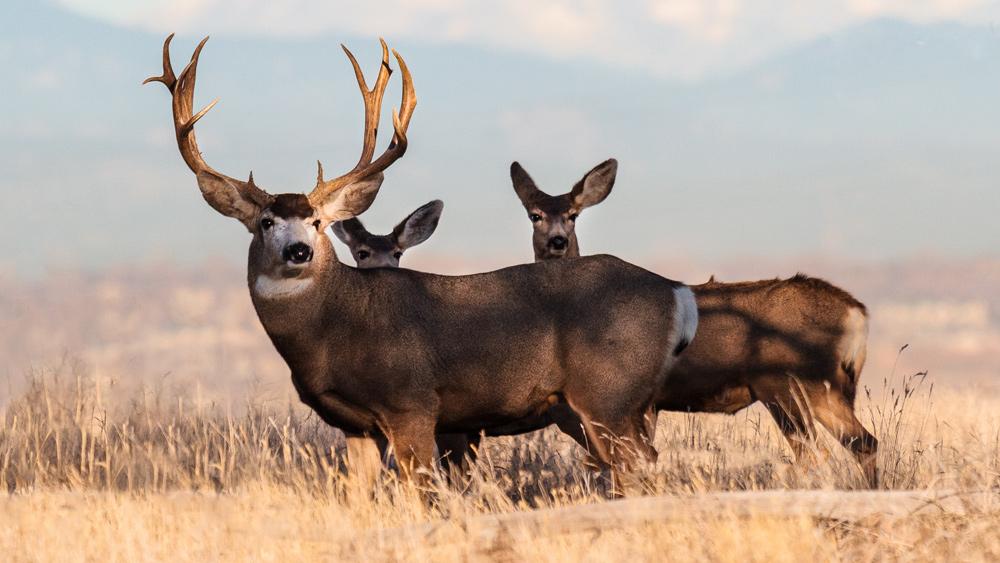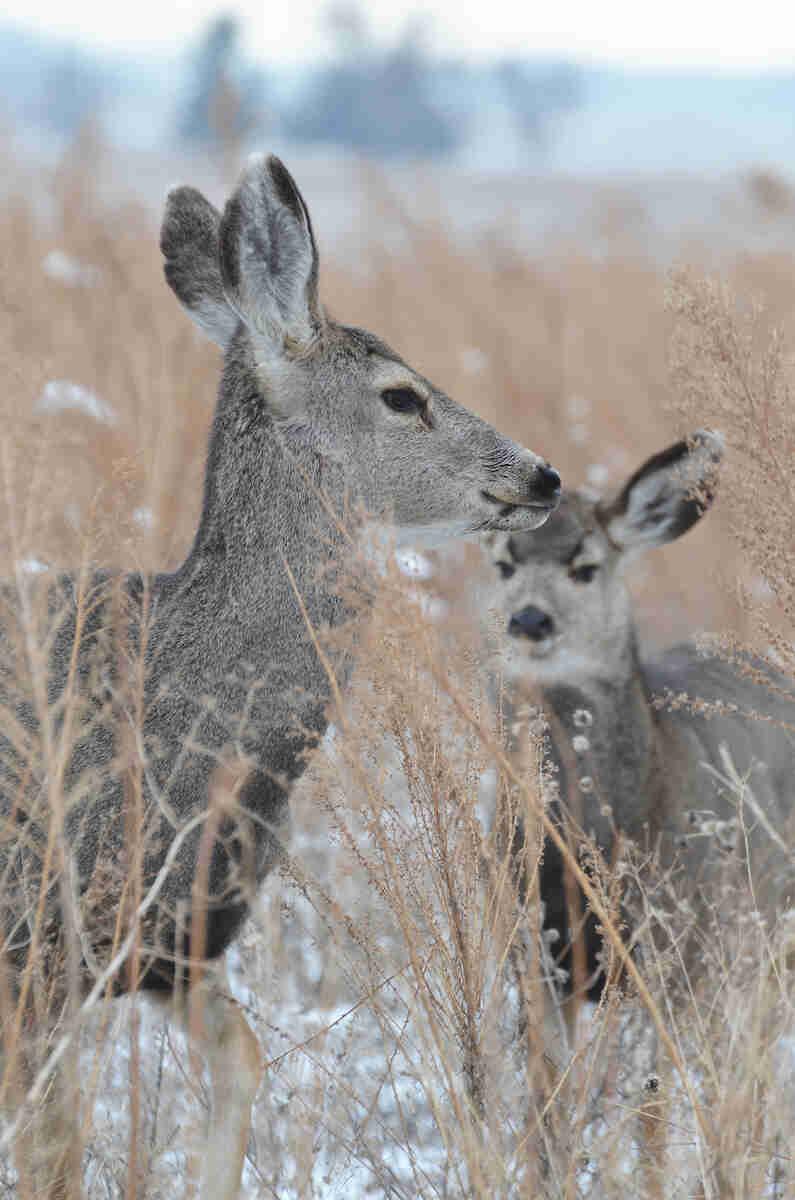Mule Deer
Full Article
Mule deer (Odocoilus hemionus) belong to the Cervidae family, hoofed mammals that have antlers, which also include elk (Cervus elaphus), moose (Alces alces), and caribou (Rangifer tarandus). There are numerous sub-classifications of deer, but the most distinctive include mule deer and white-tailed deer (O. virginianus). White-tailed deer are common throughout much of North America, and mule deer are common throughout western North America; both species are common throughout much of Colorado. The Latin term hemionus means “half mule,” referring to the relatively large ears characteristic of mule deer.
History
Mule deer evolved in North America and are well adapted to western landscapes. Colorado holds extensive mule deer habitat and supports some of the largest mule deer numbers when compared to other states and the Canadian provinces. Mule deer in Colorado and other western states have experienced large fluctuations in population size due to a variety of factors such as changes in habitat quality and quantity, severe weather, population management, predation, disease, and interactions with elk. Market hunting to feed miners and early settlers in the late nineteenth century initially reduced deer numbers in Colorado, and low deer numbers continued into the early 1900s as the state became more populated. Concern over low deer numbers during this period resulted in the first restrictions on deer hunting and also included predator control efforts to benefit deer populations.
Mule deer populations began to recover during the early 1930s and continued to increase for the next several decades, largely due to the advent and refinement of modern wildlife management techniques and changes in agricultural practices. Relatively high mule deer populations continued through the 1980s, but a population decline became evident during the 1990s, and the population has recently stabilized at lower numbers. Over the past forty years, mule deer populations in Colorado have ranged from above 600,000 to about 400,000 today. The exact reason for the most recent decline is uncertain, but it is likely related to habitat loss from human expansion and development, increased elk and predator populations, and changing weather patterns.
Characteristics and Habitat
 Mule deer are mid-sized ruminants exhibiting a relatively low rumen to body-size ratio and a higher metabolic rate when compared with larger cervids. Mule deer are selective foragers, feeding on a variety of grasses, forbs, and shrubs. The animals prefer vegetated areas that not only provide them with ample foraging but also with both thermal and hiding cover. Thus, areas characterized by both vegetative and topographic diversity provide good mule deer habitat.
Mule deer are mid-sized ruminants exhibiting a relatively low rumen to body-size ratio and a higher metabolic rate when compared with larger cervids. Mule deer are selective foragers, feeding on a variety of grasses, forbs, and shrubs. The animals prefer vegetated areas that not only provide them with ample foraging but also with both thermal and hiding cover. Thus, areas characterized by both vegetative and topographic diversity provide good mule deer habitat.
In Colorado mule deer typically breed during mid-to-late November and produce their young during June. Females commonly produce twins, with occasional singletons and rare triplets. Fawns are typically weaned by eight to ten weeks of age and become reproductively mature as yearlings. Only males (bucks) grow antlers, which shed and re-grow annually and increase in size as the animals mature. Males compete for the opportunity to breed with multiple females, ensuring the healthiest individuals pass along their genes to their offspring. Mule deer life span typically ranges from about twelve to fifteen years.
 Because of western Colorado’s topographic diversity, many mule deer populations migrate from high-elevation summer ranges to low-elevation winter ranges. In Colorado higher elevations receive increased moisture during spring and summer and thus provide enhanced forage conditions for deer. As fall approaches and temperatures drop with intermittent snowstorms, plants become less palatable; when deeper snows make plants unavailable at higher elevations, mule deer seek lower-elevation winter ranges where plants (primarily shrubs) are more easily accessible. Mule deer migration typically occurs during April, May, and October. Mule deer in Colorado typically migrate twenty to thirty miles between summer and winter ranges. Because forage quantity and quality are reduced during winter, deer exhibit a negative energy balance and lose weight over winter. Winter is the most critical period for deer survival, and severe winters with prolonged deep snow and cold temperatures can result in high mortality rates, especially for the young.
Because of western Colorado’s topographic diversity, many mule deer populations migrate from high-elevation summer ranges to low-elevation winter ranges. In Colorado higher elevations receive increased moisture during spring and summer and thus provide enhanced forage conditions for deer. As fall approaches and temperatures drop with intermittent snowstorms, plants become less palatable; when deeper snows make plants unavailable at higher elevations, mule deer seek lower-elevation winter ranges where plants (primarily shrubs) are more easily accessible. Mule deer migration typically occurs during April, May, and October. Mule deer in Colorado typically migrate twenty to thirty miles between summer and winter ranges. Because forage quantity and quality are reduced during winter, deer exhibit a negative energy balance and lose weight over winter. Winter is the most critical period for deer survival, and severe winters with prolonged deep snow and cold temperatures can result in high mortality rates, especially for the young.
Economics
Mule deer are a valued game species in Colorado, generating about $115 million annually from license fees, fuel, hotels, supplies, and other associated transactions. Hunters travel from all over the world to hunt mule deer in Colorado, making the animals an important revenue source for many Colorado towns during the fall hunting season. The world record mule deer buck came from Dolores County, Colorado in 1972.
10th Grade
Mule deer (Odocoilus hemionus) belong to the Cervidae family. They are hoofed mammals that have antlers. This family also includes elk (Cervus elaphus), moose (Alces alces), and caribou (Rangifer tarandus). There are numerous sub-classifications of deer. The most distinctive include mule deer and white-tailed deer (O. virginianus). White-tailed deer are common throughout much of North America. Mule deer are common throughout western North America. Both species are common throughout much of Colorado. The Latin term hemionus means “half mule,” referring to the relatively large ears of mule deer.
History
Mule deer evolved in North America and are well adapted to western landscapes. Colorado has extensive mule deer habitat. The state supports some of the largest mule deer numbers in the country. Mule deer populations have fluctuated in size due to a variety of factors. Changes in habitat, severe weather, predation, disease have all affected population size. Hunting to feed miners and early settlers in the late nineteenth century initially reduced deer numbers in Colorado. Low deer numbers continued into the early 1900s as the state became more populated. Concern over low deer numbers resulted in the first restrictions on deer hunting.
Mule deer populations began to recover during the early 1930s. The population continued to increase for the next several decades. This was due to the development and refinement of modern wildlife management techniques. However, a population decline happened during the 1990s. The population has recently stabilized at lower numbers. Over the past forty years, mule deer populations in Colorado have ranged from above 600,000 to about 400,000 today. The exact reason for the most recent decline is uncertain. It is likely related to habitat loss from development, increased predator populations, and changing weather patterns.
Characteristics and Habitat
Mule deer are selective foragers. They feed on a variety of grasses and shrubs. The animals prefer areas that provide them with ample foraging and hiding cover.
In Colorado mule deer typically breed during mid-to-late November. They produce their young in June. Females commonly have twins, with occasional singletons and rare triplets. Fawns are typically weaned by eight to ten weeks of age. They become reproductively mature as yearlings.
Only males (bucks) grow antlers. Bucks shed and re-grow their antlers annually. Their antlers increase in size as the animals mature.
Males compete to breed with multiple females. This ensures the healthiest animals pass on their genes. Mule deer life span typically ranges from about twelve to fifteen years.
Many mule deer populations migrate from high-elevation summer ranges to low-elevation winter ranges. In Colorado, higher elevations receive more moisture in spring and summer. This provides better forage conditions for deer. When snow covers plants at higher elevations, mule deer seek lower-elevation winter ranges where plants are more accessible. Mule deer migration typically occurs during April, May, and October. Mule deer in Colorado typically migrate twenty to thirty miles between summer and winter ranges.
Because forage quantity and quality are reduced during winter, deer lose weight over winter. Winter is the most critical period for deer survival. Severe winters with prolonged deep snow and cold temperatures can result in high death rates, especially for the young.
Economics
Mule deer are a valued game species in Colorado. Hunters travel from all over the world to hunt mule deer in Colorado, making the animals an important revenue source for many Colorado towns during the fall hunting season. Deer hunting generates about $115 million annually from license fees, fuel, hotels, and supplies. The world record mule deer buck came from Dolores County, Colorado in 1972.
8th Grade
Mule deer belong to the Cervidae family. They are hoofed mammals that have antlers. This family also includes elk, moose, and caribou. Mule deer are common throughout western North America.
History
Mule deer evolved in North America. They are well adapted to western landscapes. Colorado has extensive mule deer habitat. The state supports some of the largest mule deer numbers in the country.
Mule deer populations fluctuate. Changes in habitat and severe weather have affected population size.
Hunting to feed miners and early settlers reduced deer numbers in Colorado. Low deer numbers continued into the early 1900s as the state became more populated. Concern over low numbers caused the first restrictions on deer hunting.
Mule deer populations began to recover during the early 1930s. The population continued to increase for the next several decades. This was due to the development of modern wildlife management techniques. However, a population decline happened during the 1990s. The population has recently stabilized at lower numbers. Over the past forty years, mule deer numbers in Colorado have ranged from above 600,000 to about 400,000 today. The exact reason for the most recent decline is uncertain. It is likely related to habitat loss and changing weather patterns.
Characteristics and Habitat
Mule deer are selective foragers. They feed on a variety of grasses and shrubs. They prefer areas that provide them with foraging and hiding cover.
In Colorado, mule deer typically breed in November. They produce young in June. Females commonly have twins. Fawns are typically weaned by eight to ten weeks of age.
Only males (bucks) grow antlers. Bucks shed and re-grow their antlers every year. Their antlers increase in size as the animals mature.
Males compete to breed with multiple females. This ensures the healthiest animals pass on their genes. Mule deer life span typically ranges from about twelve to fifteen years.
Mule deer migrate from high-elevation summer ranges to low-elevation winter ranges. Higher elevations receive more moisture in spring and summer. This provides better forage conditions for deer. When snow covers plants, mule deer go to lower elevations. Mule deer migration occurs during April, May, and October. Mule deer usually migrate twenty to thirty miles.
Because there is less food during winter, deer lose weight. Winter is the most dangerous time for mule deer. Long periods of deep snow and cold temperatures can result in high death rates.
Economics
Mule deer are a valued game species. Hunters come from all over the world to hunt mule deer in Colorado. The animals are an important revenue source. Deer hunting generates about $115 million per year.
The world record mule deer buck came from Dolores County, Colorado in 1972.
4th Grade
Mule deer belong to the Cervidae family. They are hoofed mammals that have antlers. This family also includes elk, moose, and caribou. Mule deer are common throughout western North America.
History
Mule deer evolved in North America. They are well adapted to western landscapes. Colorado has extensive mule deer habitat. The state supports some of the largest mule deer numbers in the country.
Mule deer populations fluctuate. Changes in habitat and severe weather have affected population size.
Hunting to feed miners and early settlers reduced deer numbers in Colorado. Low deer numbers continued into the early 1900s as the state became more populated. Concern over low numbers caused the first restrictions on deer hunting.
Mule deer populations began to recover during the early 1930s. The population continued to increase for the next several decades. This was due to the development of modern wildlife management techniques. However, a population decline happened during the 1990s. The population has recently stabilized at lower numbers. Over the past forty years, mule deer numbers in Colorado have ranged from above 600,000 to about 400,000 today. The exact reason for the most recent decline is uncertain. It is likely related to habitat loss and changing weather patterns.
Characteristics and Habitat
Mule deer are selective foragers. They feed on a variety of grasses and shrubs. They prefer areas that provide them with foraging and hiding cover.
In Colorado, mule deer typically breed in November. They produce young in June. Females commonly have twins. Fawns are typically weaned by eight to ten weeks of age.
Only males (bucks) grow antlers. Bucks shed and re-grow their antlers every year. Their antlers increase in size as the animals mature.
Males compete to breed with multiple females. This means the healthiest animals pass on their genes. Mule deer life span ranges from about twelve to fifteen years.
Mule deer migrate from high-elevation summer ranges to low-elevation winter ranges. Higher elevations receive more moisture in spring and summer. This provides better forage for deer. When snow covers plants, mule deer go to lower elevations. Mule deer migration occurs during April, May, and October. Mule deer usually migrate twenty to thirty miles.
Because there is less food during winter, deer lose weight. Winter is the most dangerous time for mule deer. Long periods of deep snow and cold temperatures can result in high death rates.
Economics
Mule deer are a valued game species. Hunters come from all over the world to hunt mule deer in Colorado. The animals are an important revenue source. Deer hunting generates about $115 million per year.










